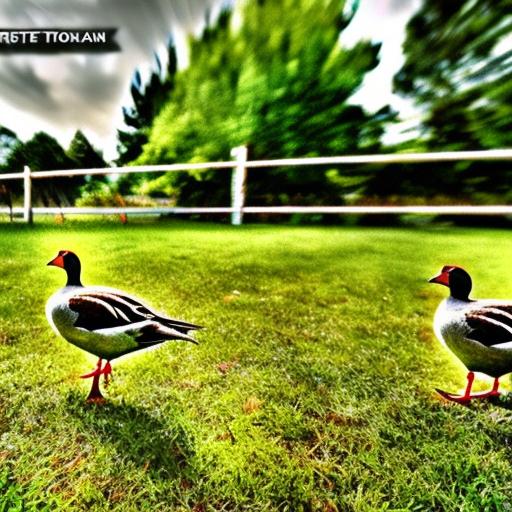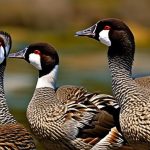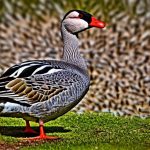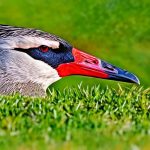Geese are large waterfowl that are known for their distinctive honking sound and V-shaped flying formations. They are highly adaptable birds that can be found in a variety of habitats, including urban areas. Geese are social animals that often gather in large flocks, and they have a strong instinct to protect their territory.
While geese can be a beautiful sight to behold, they can also be a nuisance when they invade yards and gardens. They have a voracious appetite and can quickly decimate lawns and crops. Additionally, their droppings can create unsightly messes and pose health risks. Geese are also known to be aggressive towards humans and pets, especially during nesting season.
Key Takeaways
- Geese can cause damage to yards and gardens with their droppings and feeding habits.
- There are different types of fences that can be used to keep geese out, including electric and netting fences.
- A successful geese-proof fence should be at least 4 feet tall and have a slope or overhang to prevent geese from flying over.
- Materials needed for fence installation include fence posts, wire mesh, and a post hole digger.
- Before installing a fence, it’s important to remove any food sources and make sure the yard is free of debris that could attract geese.
Types of Fences to Keep Geese Out of Your Yard
There are several types of fences that can be used to keep geese out of your yard. The most common types include chain-link fences, electric fences, and netting fences.
Chain-link fences are a popular choice because they are durable and provide a physical barrier that geese cannot easily penetrate. However, they may not be the most aesthetically pleasing option and can be expensive to install.
Electric fences work by delivering a mild electric shock to deter geese from entering your yard. They are effective at keeping geese out, but they require regular maintenance to ensure they remain functional. Electric fences can also be dangerous for children and pets if not installed properly.
Netting fences are another option for keeping geese out of your yard. They consist of a series of poles with netting stretched between them. The netting acts as a physical barrier that prevents geese from entering your yard. Netting fences are relatively inexpensive and easy to install, but they may not be as effective as other types of fences.
Designing an Effective Fence to Deter Geese
When designing a fence to keep geese out of your yard, there are several factors to consider. First, you need to determine the height of the fence. Geese can fly, so the fence should be at least 4 feet tall to prevent them from easily hopping over it. Additionally, the fence should be buried at least 6 inches into the ground to prevent geese from digging under it.
Another important factor to consider is the spacing between the fence posts or wires. Geese have long necks and can reach through small gaps, so the spacing should be no more than 2 inches. This will prevent geese from being able to access your yard.
To make your fence more effective, you can also add visual deterrents such as flags or reflective tape. These will create movement and noise that will scare away geese. Additionally, you can plant tall shrubs or trees near the fence to create a physical barrier that will make it more difficult for geese to access your yard.
Materials and Tools Required for Fence Installation
To install a fence to keep geese out of your yard, you will need several materials and tools. The materials you will need include fence posts, fencing material (such as chain-link or netting), concrete mix, and hardware (such as screws or nails). You may also need additional materials depending on the type of fence you choose.
The tools you will need for fence installation include a post hole digger or auger, a level, a tape measure, a hammer or drill, and a saw. You may also need a wheelbarrow and shovel for mixing and pouring concrete.
Each item is necessary for different aspects of the fence installation process. The fence posts are used to support the fencing material and provide stability. The concrete mix is used to secure the fence posts in the ground. The hardware is used to attach the fencing material to the posts.
Preparing Your Yard for Fence Installation
Before installing the fence, there are several steps you should take to prepare your yard. First, you should mark the boundaries of your yard to ensure that the fence is installed in the right location. This can be done by placing stakes or flags at the corners of your property.
Next, you should clear any debris or obstacles from the area where the fence will be installed. This includes removing rocks, branches, and any other items that could interfere with the installation process.
You should also check for any underground utilities, such as gas or water lines, before digging any holes for the fence posts. This can be done by contacting your local utility company and requesting a utility locate service.
Finally, you should ensure that the ground is level and free of any obstructions. This will make it easier to install the fence and ensure that it remains stable.
Step-by-Step Guide to Building a Geese-Proof Fence
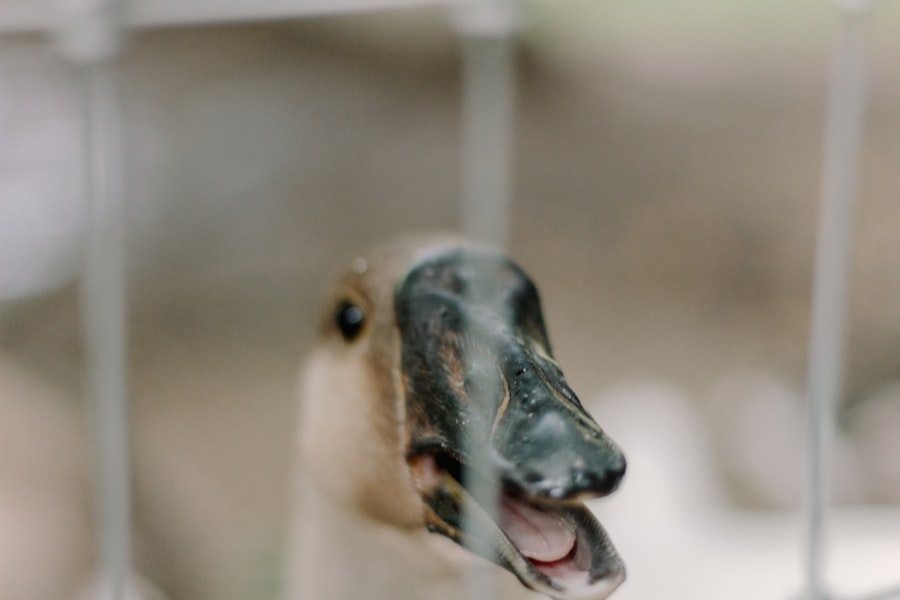
Building a geese-proof fence requires careful planning and attention to detail. Here is a step-by-step guide to help you through the process:
1. Measure and mark the boundaries of your yard: Use a tape measure and stakes or flags to mark the corners of your property.
2. Dig holes for the fence posts: Use a post hole digger or auger to dig holes for the fence posts. The holes should be at least 2 feet deep and spaced 6 to 8 feet apart.
3. Set the fence posts in concrete: Mix concrete according to the manufacturer’s instructions and pour it into each hole around the fence posts. Use a level to ensure that the posts are straight and plumb.
4. Attach the fencing material to the posts: Depending on the type of fence you choose, you may need to attach the fencing material to the posts using screws or nails. Follow the manufacturer’s instructions for proper installation.
5. Secure the bottom of the fence: To prevent geese from digging under the fence, bury the bottom of the fence at least 6 inches into the ground. You can also use rocks or bricks to weigh down the bottom of the fence.
6. Add visual deterrents: To make your fence more effective, you can add visual deterrents such as flags or reflective tape. These will create movement and noise that will scare away geese.
7. Plant tall shrubs or trees near the fence: To create a physical barrier that will make it more difficult for geese to access your yard, you can plant tall shrubs or trees near the fence.
Maintenance and Repair of Geese Deterrent Fences
To ensure that your geese deterrent fence remains effective, regular maintenance is necessary. Here are some tips for maintaining and repairing your fence:
1. Inspect the fence regularly: Check the fence regularly for any signs of damage or wear. Look for loose or missing hardware, broken posts, or holes in the fencing material.
2. Repair any damage immediately: If you notice any damage to the fence, repair it as soon as possible. Replace any broken posts or sections of fencing material, and tighten any loose hardware.
3. Keep vegetation trimmed: Trim any vegetation near the fence to prevent it from providing a bridge for geese to access your yard.
4. Clean up droppings regularly: Geese droppings can be unsightly and pose health risks. Clean up droppings regularly to keep your yard clean and discourage geese from returning.
5. Reinforce weak areas: If you notice any weak areas in the fence, reinforce them with additional hardware or fencing material.
Alternative Methods for Keeping Geese Out of Your Yard
While fences are an effective way to keep geese out of your yard, there are also alternative methods that you can try. These methods include using repellents, installing decoys, and creating barriers.
Repellents can be applied to your yard to make it less attractive to geese. These repellents can be in the form of sprays or granules and are typically made from natural ingredients that geese find unpleasant.
Decoys, such as plastic owls or coyotes, can be placed in your yard to scare away geese. These decoys mimic natural predators and can be effective at deterring geese from entering your yard.
Creating barriers, such as hedges or fences made from plants, can also be effective at keeping geese out of your yard. These barriers create a physical barrier that geese cannot easily penetrate.
Each method has its pros and cons. Repellents can be effective but may need to be reapplied regularly. Decoys can be effective but may lose their effectiveness over time as geese become accustomed to them. Creating barriers can be effective but may require regular maintenance to ensure they remain intact.
Tips for Keeping Geese Away from Your Property
In addition to installing a fence or using alternative methods, there are several other tips you can follow to keep geese away from your yard:
1. Remove food sources: Geese are attracted to areas with abundant food sources. Remove any food sources from your yard, such as fallen fruit or bird feeders.
2. Install motion-activated sprinklers: Motion-activated sprinklers can startle geese and deter them from entering your yard. These sprinklers are triggered by movement and spray water in the direction of the movement.
3. Use noise deterrents: Geese are sensitive to noise and can be scared away by loud sounds. Use noise deterrents such as wind chimes or ultrasonic devices to deter geese from entering your yard.
4. Install reflective surfaces: Geese are wary of reflective surfaces because they cannot see their own reflection in them. Install reflective surfaces such as mirrors or shiny objects to deter geese from entering your yard.
5. Create a physical barrier: If you have a pond or other water feature in your yard, create a physical barrier around it to prevent geese from accessing it. This can be done using netting or fencing material.
Benefits of Installing a Fence to Keep Geese Out of Your Yard
Installing a fence to keep geese out of your yard offers several benefits. First and foremost, it protects your property from the damage caused by geese. Geese can quickly decimate lawns and crops, so a fence can help preserve the beauty and value of your yard.
A fence also provides a physical barrier that can prevent geese from entering your yard and causing problems. It creates a clear boundary that geese are less likely to cross, reducing the likelihood of conflicts between geese and humans or pets.
Furthermore, a fence can improve your quality of life by allowing you to enjoy your yard without the presence of geese. Geese can be noisy and messy, so having a fence in place can create a peaceful and clean environment for you and your family to enjoy.
In conclusion, geese can be a nuisance when they invade yards and gardens. They have a strong instinct to protect their territory and can cause damage to lawns and crops. However, there are several types of fences that can be used to keep geese out of your yard. By designing an effective fence, using the right materials and tools, and following proper installation techniques, you can successfully deter geese from entering your yard. Additionally, there are alternative methods and tips that you can try to keep geese away from your property. Installing a fence to keep geese out of your yard offers several benefits, including protecting your property from damage, creating a peaceful environment, and improving your quality of life.
If you’re looking for effective ways to keep geese out of your yard, you may want to consider installing a sturdy fence. Fences can be a great deterrent for geese, preventing them from entering your property and causing damage. In fact, a recent article on Poultry Wizard explores the benefits of using fences to keep geese away. To learn more about this topic, check out their article on “The Importance of Fences in Keeping Geese Out” here. Additionally, if you’re interested in other poultry-related topics, Poultry Wizard also offers articles on “How Many Eggs Do Geese Lay?” here and “The Chicken Coop Country Diner” here.
Meet Walter, the feathered-friend fanatic of Florida! Nestled in the sunshine state, Walter struts through life with his feathered companions, clucking his way to happiness. With a coop that’s fancier than a five-star hotel, he’s the Don Juan of the chicken world. When he’s not teaching his hens to do the cha-cha, you’ll find him in a heated debate with his prized rooster, Sir Clucks-a-Lot. Walter’s poultry passion is no yolk; he’s the sunny-side-up guy you never knew you needed in your flock of friends!

